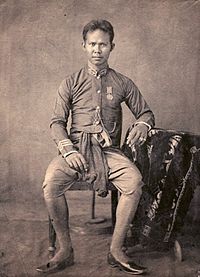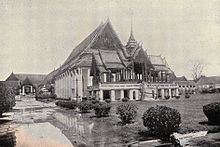| Viceroy of Siam | |
|---|---|
| กรมพระราชวังบวรสถานมงคล | |
 Second-longest reigning Second-longest reigningMaha Sura Singhanat 1782–3 November 1803 | |
| Style | His Royal Highness |
| Type | |
| Residence | Front Palace |
| Appointer | Monarch |
| Term length | Life tenure or until accession as Sovereign |
| Formation | 1438 (587 years ago) (1438) |
| First holder | Ramesuan |
| Final holder | Wichaichan |
| Abolished | 28 August 1885 (139 years ago) (1885-08-28) |
| Succession | Crown Prince of Siam |
| Unofficial names | Front Palace lord |
| Deputy | Deputy Viceroy of Siam |

Krom Phra Ratchawang Bowon Sathan Mongkhon กรมพระราชวังบวรสถานมงคล, colloquially known as the Front Palace (Thai: วังหน้า, RTGS: Wang Na), was the title of the uparaja of Siam, variously translated as "viceroy", "vice king" or "Lord/Prince of the Front Palace", as the titleholder resided in the physical residence of the same name. The office of Front Palace was considered second only to the king and regarded as the heir presumptive. The name, with its dual meaning, originated in the Ayutthaya period, and the holder later gained significant powers during the Rattanakosin period. Front Palace occupants were usually a son or brother of the reigning monarch. The office existed until the death of the last occupant, Prince Wichaichan, in 1885. King Chulalongkorn then abolished the office of an heir presumptive, introducing in its stead the Western concept of a crown prince as heir apparent, and styled the new office "Crown Prince of Siam".
Ayutthaya period
The Uparaja or Uparat concept of a Viceroy was of Greater Indian origin. In 1448, Sukhothai King Trailokkanat of was crowned as the king of Ayutthaya, uniting the two kingdoms. During the 15th century, the Kingdom of Sukhothai, centered on Phitsanulok, served as the seat of most of Uparats, as they were, with few exceptions, also king of Sukhothai. After the first fall of Ayutthaya in 1569, Maha Thammaracha crowned his son Naresuan as Uparat and king of Sukhothai/Phitsanulok. Naresuan then had a palace built in front of his Royal Palace, to be his son's place of residence when visiting Ayutthaya—thereby giving rise to the name "Front Palace." In 1583, Naresuan annexed the Sukhothai kingdom to Ayutthaya, and Phitsanulok ceased to be the seat of the Uparat. After his coronation, Naresuan appointed his brother Ekathotsarot to be the Uparat, stating that his brother in the Front Palace had equal status to the King in the Royal Palace.
Phetracha in 1688 appointed his son Luang Sorasak (later Sanpet VIII) as the Uparat living at the Front Palace. For the first time the descriptive term used was "Krom Phrarajawang Bovorn Sathan Mongkol" (Thai: กรมพระราชวังบวรสถานมงคล) (lit. The Great Auspicious Place). The Uparat was usually the brother of the king, and only heir presumptive to the throne, not heir apparent. This created an air of uncertainty about the succession upon the death of the king; keeping the heir close at hand in the Great Auspicious Place proved a means for keeping an eye on him, lest he presume too much. When the Uparat died before the king, the title often remained vacant for several years, until the King deigns to appoint a new vice-king.
Rattanakosin period

With the foundation of the Chakri dynasty in 1782, Phutthayotfa Chulalok made his younger brother Bunma the Front Palace (as Maha Sura Singhanat). Maha Sura Singhanat supervised the construction of Front Palace in Bangkok. Later Front Palaces continued the expansion of the palace. Prince Itsarasunthon was the only Front Palace who did not reside in the Front Palace but instead lived at the Thonburi Palace. Ironically, with the exception of Prince Itsarasunthon (who succeeded to the throne as Phutthaloetla Naphalai), none of the Rattanakosin Front Palaces were actually crowned as they were mostly the monarch's siblings. During this time the Vice-King resided in the Front Palace (วังหน้า: Wang Na) north of the Grand Palace, which is now the main building of the Bangkok National Museum.
The Front Palaces during the Rattanakosin period wielded great power, with their own private army and even a navy. In 1851, King Mongkut made his brother Pinklao the Front Palace and then crowned him as a King equal in rank to himself, as was the case of Naresuan and Ekatotsarot. Pinklao also received all the styles and titles usually reserved only for the monarch; to Europeans he refers to himself as the Second King. In 1868, after the coronation of young Chulalongkorn, his regent Sri Suriwongse arranged the grant of the title of Front Palace to Pinklao's son Prince Yingyot as Front Palace Wichaichan.
Though the office had been superseded, Mahidol Adulyadej, the Prince Father was posthumously given an equivalent rank.
End to the system
Main article: Front Palace crisis See also: Crown Prince of ThailandThe conflicts between the reformist King Chulalongkorn and conservative Vice King came to a head in the so-called Front Palace Crisis in 1874—a fire in the Grand Palace was attributed to the Vice-King Wichaichan, who sought protection in the British consulate. The crisis started due to the fast-paced reforms started by the young King Chulalongkorn. As a result, the reforms were stalled for several years, and when the Vice King died in 1885, the whole Uparat system was abolished by the King. Instead he named his son as heir and Crown Prince.
List of Front Palace lords
Ayutthaya
| Front Palace | Appointed by | Relation to the monarch | Reign | Ascension or Death |
|---|---|---|---|---|
| Ramesuan | Borommarachathirat II | Son | 1438–1448 | as Borommatrailokkanat |
| Chettha | Borommatrailokkanat | Son | 1485–1488 | as Ramathibodi II |
| Chettha | Borommarachathirat III | Younger brother | 1488–1491 | as Ramathibodi II |
| Athittayawong | Ramathibodi II | Son | 1526–1529 | as Borommarachathirat IV |
| Chairacha | Borommarachathirat IV | Younger brother | 1529–1533 | as Chairachathirat |
| Chan | Worawongsathirat | Younger brother | 1548 (42 days) | Assassinated |
| Ramesuan | Maha Chakkraphat | Son | 1548–1563 | Died |
| Mahin | Maha Chakkraphat | Son | 1564–1568 | as Mahinthrathirat |
| Naresuan | Maha Thammaracha | Son | 1571–1590 | as Sanphet II (Naresuan the Great) |
| Ekathotsarot | Naresuan the Great | Younger brother | 1590–1605 | as Sanpet III (Ekathotsarot) |
| Sutat | Ekathotsarot | Son | 1605–1610 | Died |
| Si Sorarak | Songtham | Son | 1620 (10 days) | Died |
| Narai | Si Suthammaracha | Nephew | 1656 (2 months 17 days) | as Ramathibodi III (Narai the Great) |
| Sorasak | Phetracha | Son | 1688–1703 | as Sanphet VIII (Suriyenthrathibodi) |
| Phet | Suriyenthrathibodi | Son | 1703–1708 | as Sanphet IX (Thai Sa) |
| Phon | Thai Sa | Brother | 1708–1732 | as Borommakot |
| Senaphithak | Borommakot | Son | 1732–1746 | Executed |
| Phonphinit | Borommakot | Son | 1757–1758 | as Uthumphon |
Thonburi
| Front Palace | Appointed by | Relation to the monarch | Reign | Ascension or Death |
|---|---|---|---|---|
| Inthraphithak | Taksin | Son | –1782 | Executed |
Rattanakosin
| Front Palace | Appointed by | Relation to the monarch | Reign | Ascension or Death |
|---|---|---|---|---|
| Maha Sura Singhanat | Phutthayotfa Chulalok | Brother | 1782–1803 | Died |
| Itsarasunthon | Phutthayotfa Chulalok | Son | 1806–1809 | as Phutthaloetla Naphalai |
| Maha Senanurak | Phutthaloetla Naphalai | Brother | 1809–1817 | Died |
| Sakdiphonlasep | Nangklao | Uncle | 1824–1832 | Died |
| Pinklao | Mongkut | Brother | 1851–1866 | Crowned as co-ruler with Mongkut |
| Wichaichan | Chulalongkorn | Cousin | 1868–1885 | Died, title abolished |
With the death of Wichaichan, Chulalongkorn did not appoint any new Front Palaces. In 1886, Chulalongkorn made his son Prince Maha Vajirunhis, "Crown Prince of Siam", therefore abolishing the title of Front Palace altogether.
See also
- Rear Palace—Deputy Viceroy of Siam
- 1924 Palace Law of Succession
- Uparaja—for other Southeast Asian equivalents
- Crown Prince of Thailand
- Chakri Dynasty
- Monarchy of Thailand
- Prince Vajirunhis—first Crown Prince of Siam
References
- "HM Second King Pinklao". Soravij. Archived from the original on 2013-05-10. Retrieved 2009-10-17.
- ราชกิจจานุเบกษา, ประกาศเฉลิมพระนามาภิไธย สมเด็จพระบรมราชชนก และ สมเด็จพระบรมราชชนนี, เล่ม ๘๗, ตอน ๕๒, ๑๒ มิถุนายน พ.ศ. ๒๕๑๓, ฉบับพิเศษ หน้า ๑
| Viceroys and Deputy Viceroys of Siam | |||||||
|---|---|---|---|---|---|---|---|
| Ayutthaya Kingdom |
| ||||||
| Thonburi Kingdom |
| ||||||
| Rattanakosin Kingdom |
| ||||||
| Viceroys of the Chakri dynasty | ||
|---|---|---|
| First Reign |
|  |
| Second Reign | ||
| Third Reign | ||
| Fourth Reign |
| |
| Fifth Reign |
| |
| ||